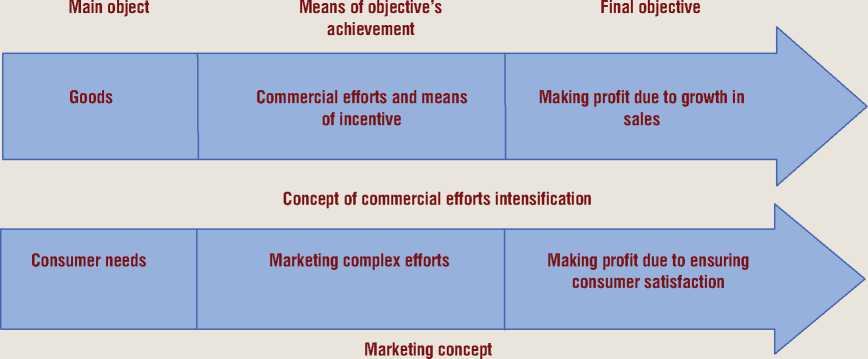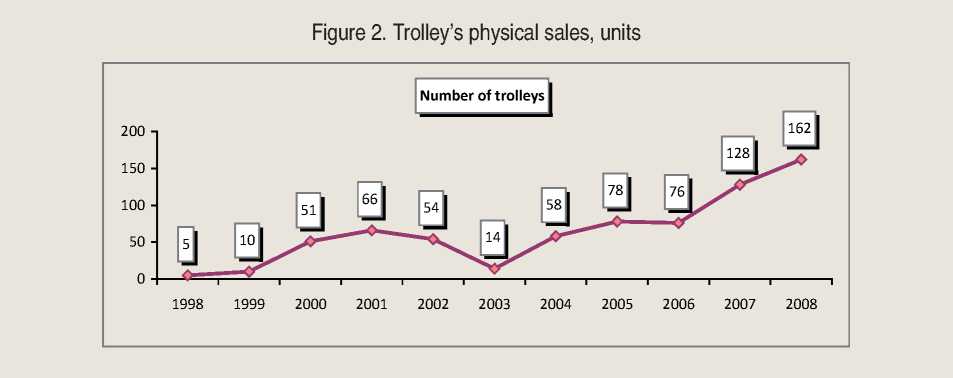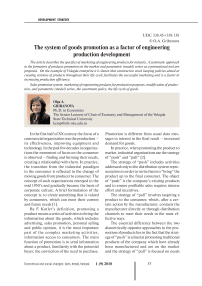The system of goods promotion as a factor of engineering production development
Автор: Gribanova Olga Aleksandrovna
Журнал: Economic and Social Changes: Facts, Trends, Forecast @volnc-esc-en
Рубрика: Development strategy
Статья в выпуске: 1 (9) т.3, 2010 года.
Бесплатный доступ
The article describes the specifics of marketing of engineering products for industry. A systematic approach to the formation of products promotion on the market and parametric (model) series as a promotional tool are proposed. On the example of Vologda enterprise it is shown that constructive stock keeping policies aimed at creating versions of products throughout their life cycle facilitates the successful marketing and is a factor in increasing production efficiency.
Sales promotion system, marketing of engineering products for production purposes, modification of production, and parametric (model) series, assortment policy, life cycle of goods
Короткий адрес: https://sciup.org/147223172
IDR: 147223172 | УДК: 338.45+339.138
Текст научной статьи The system of goods promotion as a factor of engineering production development
In the first half of XX century the focus of a commercial organization was the production – its effectiveness, improving equipment and technology. In the past few decades in organizations the movement of focus on the consumer is observed – finding and forming their needs, creating a relationship with them. In practice, the transition from the industrial paradigm to the consumer is reflected in the change of moving goods from producer to consumer. The concept of such organizations emerged in the mid 1950’s and gradually became the basis of corporate culture. A brief formulation of the concept is: to create something that is valued by consumers, which can meet their current and future needs [1].
By F. Kotler’s definition, promoting a product means a series of activities to bring the information about the goods, which includes advertising, sales promotion, personal selling and public opinion, it is the most important part of the complex marketing activities, information access to consumers. The main function of promotion is to send information about a product, familiarity with the potential buyer, the conviction of the need to purchase.
Promotion is different from usual data messages in interest in the final result – increased demand for goods.
In practice, when promoting the product to market, industrial organizations use the strategy of “push” and “pull” [2].
The strategy of “push” includes activities addressed only to the distribution system representatives in order to invite them to “bring” the product up to the final consumer. The object of “push” is the company’s existing products and to ensure profitable sales requires intense effort and incentives.
The strategy of “pull” involves targeting a product to the consumer, which, after a certain action by the manufacturer, contacts the manufacturer directly or through distribution channels to meet their needs in the most effective ways.
The essential difference between the two diametrically opposite approaches to the promotion of products lies in the fact that the strategy of “push” is aimed at promoting traditional products of the company which have already been manufactured and are on the market and the strategy of “pull” is focused on needs
Figure 1. Comparison of the concepts of products promotion on the market

and potential demand research, and creating product diversity on this basis. In this case the goods do not need to be pushed; the consumer will be “pulling” the product you need out of the production (fig. 1).
Comparison of the two concepts of the goods promotion leads to the assertion that the strategy of “pull” is the essence of the marketing concept that reflects the company's commitment to the theory of consumer sovereignty: to produce what consumers need and make a profit by maximizing the satisfaction of their needs.
Marketing of engineering products for industrial and technical purposes is complicated by its distinction from the marketing of the end product of individual consumption by characteristics of formation and development of demand for these products.
The first feature is the hard-deterministic nature of the demand for higher requirements to the quality of machinery and equipment that are purchased strictly for their intended purpose and for the manufacture of certain products. Rigidity of technical requirements from customers creates dependency and long-term relationship of the seller and consumer. For example, industrial consumers are turning to suppliers of machinery and equipment, when it comes to embedding machine to an existing material flow, adapting it to the specific needs of production. Refusal to cooperate with the supplier of machines forces final producers to find alternatives to the original materials, change the production technology, and this is a lengthy process. Thus, the determination of the demand for machines generates inelasticity of demand, especially since the choice of suppliers of goods targeted for production purposes is relatively small.
The second feature lies in the “secondary” character, demand for industrial goods: the demand for goods for production and technical purposes does not occur by itself, but as a consequence of demand for final products. There is a need to take into account two areas of market relations: about the products for production purposes, and at the final consumption goods. This makes manufacturers of machinery and equipment to study the demand imposed by finite, individual consumers. For example, manufacturers of sawmill equipment for the successful promotion of equipment on the market must study not only the demand for sawn wood, but the final product: the wooden houses, furniture and other products of individual consumption.
The third feature of the machines marketing is a relatively limited capacity of the market of goods for production and technical purposes to which machines are relevant. Their consumers can be either a certain branch of industry or group of enterprises with a narrow specialization. Fewer number of consumers leads to greater buyers’ power in the market that ultimately determines the machines supply.
The fourth feature is currently prevailing tendency to increase direct purchases of machinery and equipment, focusing on the specific production situation and the individual orders of special equipment. Thus, the consumers of machinery and equipment have the following manufacturing situations:
-
► low technical level of existing equipment does not provide the required level of product quality;
-
► depreciation of equipment leads to increased operating costs, increased downtime, reduced productivity;
-
► the existing equipment does not provide the full range of incoming orders;
-
► full wear of certain items oftechnological lines requires an equivalent replacement for incorporation into existing technological flux.
It seems that the complexity of the machine marketing can be overcome through constructive marketing policy, and, in particular, through the organization of products promotion on the market.
The basis for the organization of engineering products promoting to the market, in our view, must be a systematic approach as the methodology of scientific analysis and thinking, which directs the researcher to disclose the integrity of the object, to identify the diverse types of bonds in it and bringing them into a single theoretical picture. Accordingly, the essence of a systematic approach to the promotion of products on the market lies in the notion of promoting as a system of action. System approach to the organization of products promotion on the market allows for technology advancement in the form approved at the manufacturer's procedures. Documented procedures reduce or completely eliminate subjectivity peculiar to processes involving people, and reduce the risks associated with the departure of key staff, and consequently the loss of contact with consumers. Documented procedure combines the technological instructions for individual executives and can provide in general terms the sequence and content of the cycle of actions of the goods promotion:
-
• identifying customer needs;
-
• demonstrating the possibilities of the product modifications;
-
• formation of a technical proposal;
-
• developing terms of reference for the modification;
-
• addition of product line of and sales catalogue.
Promotion of products is a two-way process including at least two members: the sales manager of the manufacturer of equipment and the consumer (industrial customer). Therefore, the starting point of a promotion system is the study of potential consumers and their demand.
Potential consumer of machines, an industrial buyer, is qualified in commercial and technological field, knows the market conditions, supply of alternative providers and their competitive advantage. For example, buyers of large equipment put conditions of sale based on the characteristics of its “economic life” in certain conditions, which include:
-
• completeness, delivery and installation terms;
-
• terms and conditions of warranty;
-
• providing technological equipment, design and production management automated systems;
-
• participation in the development process;
-
• organization of service and post-services;
-
• organization of products certification, including compliance with international standards.
Competent buyers of machinery and equipment require not only a professional service, but approach to the individualization of their problems. However, the practice of interaction between supplier and buyer in the sale of new technology shows that the buyer, showing the technical requirements, primarily aimed at the quality – reliability, performance, ergonomics, design, and safety of operation – do not always fully understand what they want. Therefore the interaction of producer and consumer of equipment should begin early in the development of new technology, so that to make necessary adjustments to the specification and implement the optimal design solution for the consumer.
The practice of interaction between machine manufacturer and the potential buyer helps create original parametric series. The parameter series is the group of structurally and (or) a technologically homogeneous products, characterized by belonging to one type of product, having the same functional purpose of satisfying the same need, containing the same set of basic parameters of production and different individual characteristics. The parametric series may include modification of products, which are the development of a certain number of previously mastered items, new performance within that series or its continuation.
Original parametric series can be made up on the basic model of engineering products originally put in production. On the basis of information data and practice interactions with customers as their preferences enhance the development of new versions of products, modifications, begins. This, in turn, stimulates the appearance of new customers and further increase of information. Work on the creation of new versions of products will be more successful in the case of a continuing examination of the technological capabilities of competitors’ equipment in the domestic market and the analysis of world engineering experience. Supplemented by the necessary information on pricing, delivery terms, service and other data source the parametric series generates a range (model series) and, together with the sales catalogue becomes a marketing tool when promoting products on the market, serving as a trigger for modifications of interest from potential customers.
Thus, products promotion and the formation of range is a single continuous process that continues throughout the product lifecycle, beginning from the conception of its creation and ending with the withdrawal from the commodity program. The range becomes the embodiment of the product’s evolutionary development, its material capacities and simultaneously specific needs.
At Vologda enterprise JSC “Trans-Alfa” based on international experience and own engineering development for 11 years, two basic models of trolleybuses, initiating the formation of model lines were developed and utilized in the production (table).
Model series demonstrates the diversity of trolleys’ consumer properties allowing using public transport in specific conditions. For example, the low cabin floor allows you to equip it with a folding platform for the transportation of persons with disabilities; articulated salons increase trolleybuses’ capacity, electronic control system enables the autonomous movement and energy saving.
The variety of consumer properties makes a demand of the trolley on the market, moreover, the company can become the initiator of the
Example of trolleys’ model series formation
|
Е га СО |
Design № |
5298 |
6215 |
|
Characteristics |
Trolley with high-floor |
Articulated high-floor |
|
|
с г |
Design № |
5298-01 |
62151 |
|
Characteristics |
Trolley with low-floor |
Articulated low-floor |
|
|
Design № |
|||
|
Characteristics |
Source: data from the official site of JSC “Trans-Alfa” [Electronic resource]. – Access mode:

transaction and on this basis to establish reasonable prices and increased sales volumes (fig. 2).
The statistics reflect the high rate of growth in sales and are evidence of the dynamic development of companies able to implement technological innovations on the basis of constructive assortment policy. Product promotion on the market is facilitated due to the fact that the basis of offering goods is mass-produced basic model technologically developed in industry.
Range of products formed in a model series serves as a carrier of information about the product, is a major tool of product promotion on the market, thus providing it benefits, and contributes to successful marketing.
Thus, a systematic approach to product promotion on the market stimulates the development of the product range of engineering companies, promotes economic efficiency and becomes one of the ways to overcome the technological gap with the industry.
Список литературы The system of goods promotion as a factor of engineering production development
- Sales of large equipment: contacts technology/Tekhnomir. -2003. -№ 4. -Pp. 90-91.
- Kotler, F. Fundamentals of Marketing: translation from English/F. Kotler. -M.: Rosinter, 1996. -704 p.


